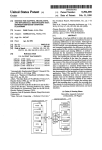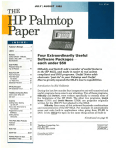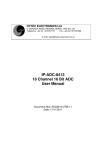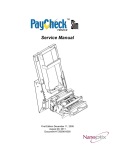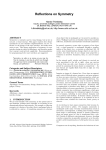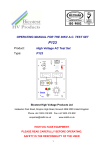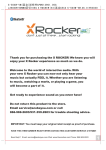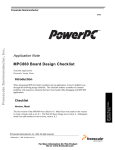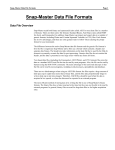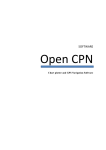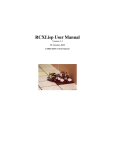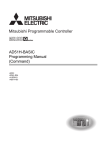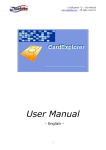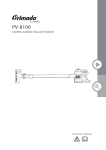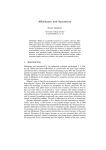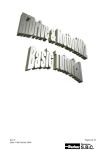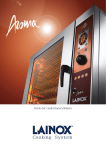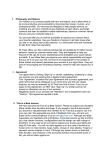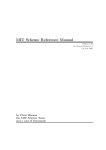Download PC-Scheme/Geneva 4.02 log
Transcript
PC-Scheme/Geneva 4.02 log Larry Bartholdi June 1, 1999 1 Short Takes • This document is there as a placeholder for all modifications done. As a principle items are not suppressed or modified; new entries are added in chronological order. • The current version is PCS 4.02, dating 1993-nov-11. A Patch level number will be increased each time a bug is found and fixed. • PCS is distributed freely in binary and source code forms. You’re allowed to use it for any purposes but military. We are working hard on documentation. . . but please be indulgent. As PCS/GE as much in common with TI’s 3.03 release, we suggest you turn to Texas Instruments’ documentation. You may order TI’s manual at the MIT press. It’s called: PC Scheme: Users Guide and Language Reference Manual, Trade Edition, Texas Instruments, 416 pp, 1990, ISBN 0–262–70040–9. • The authors assume no resposibility in case of damage due to a bug in PCS. Bug hunting and fixing is nevertheless an important activity for them. If you find a bug, please send a message to the E-Mail address below. You will be rewarded by an authentic Swiss present. . . • The official FTP server is “cui.unige.ch”. PCS is there in directory “pub/pcs”. Different file formats are present: PCSCHEME.EXE The big archive, containing everything except the source code. It is an archive made into an executable file for convenience purposes. The compressor used is ARJ, though you won’t need it. PCSLIM.EXE An archive in executable format, too. It contains fewer files: only the executables and docs. PCSCHEME.TAZ A Unix tar-file, compressed with gzip. It contains exactly the same files as PCSCHEME.EXE. PCSCHEME.FIL The list of files in the tar archive. SOURCES.EXE Another big archive, containing source code only. It is also a self-extracting ARJ file. • PCS has its own mailbox: “[email protected]”. You are asked to use this address, so that developers know at a glance they receive mail concerning PCS. The developers themselves can be reached at “[email protected]” and “[email protected]”. • This work is supported by the University of Geneva, Switzerland. 1 2 What is PCS? This program is based, and includes source code, of Texas Instrument’s PC-Scheme 3.03 (1988). PCS/GE is the most performant Scheme interpreter for MS-DOS based low-cost 16 bit microcomputers from the iAPX 86,88 series; it also runs on 386/486 computers, but is not as performant as other systems which use specific enhanced hardware capabilities, even if PCS/GE needs indeed much less memory. 2.1 Copyrights PCS/GE is protected by Texas Instrument’s Copyright (see COPYRIGHT.TXT), but is free to distribute to everyone. Release 4.xx enhancements, corrections and translated source code are the property of the authors. BGI drivers are (c) Borland International. 3 New features (since 3.03) • 486 Compatibility (which was not completely achieved by TI PCS 3.03) • Text mode interface has been extended: every existing video mode (including all graphic modes, Ega 43 lines, Vga 50 lines, Svga 132 columns. . . ) are supported. The TEXT-MODE primitive allows you to set change between modes if this can be done through an unique BIOS-call; the special mode 64 puts the adapter in Ega 43 or Vga 50 lines text if available, like Borland C’s textmode function. TEXT-MODE can do what SET-VIDEO-MODE! was doing in TI PCS. • A block cursor is emulated when necessary; it doesn’t clobber the screen and works for all video modes. • Text attributes are compatible between graphic and text modes: the four highorder bits set the background color, the four low-order bits set the foreground color. The only difference is that MSBit means blinking in text mode and Bright Background in graphic mode. • In order to achieve transparency between text and graph modes, WINDOW-SAVE-CONTENTS and WINDOW-RESTORE-CONTENTS have been extended to work in the same way no matter which mode you are in. That means you can for instance save the contents of the ’CONSOLE window, switch to graphics mode and restore it on the graphic screen as if no change occurred. Note that graphic mode windowsaving is done through pattern matching, and might not work if you’ve drawn pixels on the text. It is also not very fast. • Edwin has been adapted to use advantages of special video modes. But due to its complex storage system, the screen dimensions are only detected at startup. That means that if you want to use another screen width after window size after having edwin already started, you should call first (REMOVE-EDWIN) to unload edwin from memory and let it start up again. • You are encouraged to use the nice features of window primitives as described in your PCS reference. You might add to the window-manipulation primitives the new one coming from TI PCS 3.03: (NEW-WINDOW string) where string is the title of a new window to be created by the user, using arrow keys. • PCS/GE also introduces some simplified top-level screen manipulation primitives to help you switching to mixed text & graphic modes: (FULL-SCREEN) makes your ’CONSOLE window as big as possible, reserving the last line for 2 garbage collecting information, while (SPLIT-SCREEN n) makes the ’CONSOLE window n lines big, at the bottom of the screen, which allows you to act interactively on the graphic screen without scrolling up what you’ve drawn. • The %GRAPHICS primitive has been totally modified; no program should use it directly. All the TI graphic primitives have been removed, and you should use the new Borland Graphic Interface (BGI) instead; if you really need to, it won’t be a problem to write a compatibility module since BGI graphics are much more sophisticated and programmer-friendly. See BGI.TEX. • In addition to BGI functions, PCS/GE allows you to customize the coordinate system, linearly or not, and using as much dimensions as desired. • The READ primitive, used for the Top-Level, works now like DOSKEY: you can recall previous lines using up and down arrows, go back, insert text and so on. (PUSH-HISTORY item/list) allows you to insert a string or a list into the DOSKEY history buffer; (GET-HISTORY) returns the history as a list of strings. (CLEAR-HISTORY) empties the history. These primitives allow you to easily save and restore the DOSKEY history buffer. • EXIT now may receive a numerical parameter known as DOS return-code, which can be tested using ERRORLEVEL within a batch file, for instance. • OBJECT-HASH and OBJECT-UNHASH now give a real hash key, based on a simple additive algorithm, rather than putting all the objects in a single linked list. • DOS-GETDIR has been added for æsthetic reasons (DOS-CHDIR hasn’t been changed) • Stack-overflow during I/O and related exceptions don’t throw you away as they did before. • Transcendental functions (trigo & expt) are now built-in, using 80x87 if available or Borland’s powerful emulation otherwise. XLI has been removed. • Numerical exceptions are driven by interrupts rather than tests, which is faster and much more reliable. • The buggy Expanded and Extended versions have been replaced by a single PCS.EXE which drives Expanded Memory (LIM 3 spec or later) when available. If you have only Extended Memory on a 386 or 486 computer, use EMM386. • A new type of objects has been added: inline code. It allows you to use your own very short assembler-written functions as any other Scheme lambdafunction. A set of macro designed for Scheme objects manipulation from assembly language is given, with documentation and examples. See INLINE.DOC. • As a demo of inline-code, PEEK.FSL (which loads PEEK.BIN) implements low-level memory and bus input/output primitives. Source code is also dirtibuted (See PEEK.S and PEEK.ASM). • %LOGIOR and %LOGAND undocumented bitwise operators on 16-bits words have been replaced by true Scheme functions, accepting a variable number of arguments, and working on integers of any size: BITWISE-OR, BITWISE-AND and BITWISE-XOR. 3 • Functions accepting a variable number of arguments such as +, * and APPEND can now receive any number of arguments (even more than 62) if called with APPLY (useful for big summations, and so on). • Original PCS-MACHINE-TYPE which recognized only some Texas Computers was enhanced. It is now a list of the form ’((CPU . SPEED) NDP ROMCHKSUM) where CPU is 80x86 or 8088, NDP is 80x87 or 0 if no coprocessor found, SPEED (in MHZ) is based on a memory-transfers benchmark (the most time-consuming operation for PCS/GE) and ROMCHKSUM can be used to recognize a computer (for example the HP95LX to setup a small ’CONSOLE window and install the non-standard BGI driver; see SCHEME.INI). • PCS can now produce directly fast-load files. Given a program FOO.S, just call (FAST-SAVE-FILE "FOO.S" "FOO.FSL") and everything’s done! • Mouse... • ED... 4 Summary of PCS/GE’s New Primitives Some VM instructions changed significantly. Don’t forget to rebuild all your own FSL modules from source. 4.1 Text Mode (TEXT-MODE n) Turns video adapter into hardware mode n. This is an enhanced version of the old SET-VIDEO-MODE!. Regular values are: Devices n Size and Colors 0 1 2 3 7 64 40 × 25, Black & white 40 × 25, Color 80 × 25, Black & white 80 × 25, Color 80 × 25, Monochrome 80 × 43or50, Color CGA and superior ” ” ” Hercules and Monochrome EGA (43 lines) and VGA (50 lines) Any other value given in your video adapter user manual can be used. If the resulting mode is a “graphic mode” (in the sense of BIOS), a block-cursor will appear, and display will be slower, but PCS will still consider your are working with text only. If you want to draw and plot, always use INIT-GRAPH, RESTORE-CRT-MODE, SET-GRAPH-MODE or CLOSE-GRAPH to set-up your video adapter (see BGI.TEX). (SPLIT-SCREEN nlines) Specify how much text lines should be reserved for ’CONSOLE window (the standard top-level I/O window). When you turn to graph mode, PCS/GE calls for you SPLIT-SCREEN so your drawings won’t be scrolled as you type. You can use SPLIT-SCREEN to change the number of lines reserved for text. (FULL-SCREEN) Allocate the maximum number of lines for ’CONSOLE window. PCS/GE calls it for you when you get back to text mode. 4 (WINDOW-SET-ATTRIBUTE! window attribute value) This primitive is not new, but the meaning of value has been precised; it is not as hardware-dependent as before, and doesn’t change from text to graphic mode (assuming that you can display the same number of colors). Value is always 8 bits: | a | b | c | d || e | f | g | h | where bits a–d code for background color, bits e–f for text color. Usually, b–d and f–h are the RGB components of the color, while a & e are intensity bits (on some adapters, intense background means blinking character). (WINDOW-SAVE-CONTENTS window) (WINDOWS-RESTORE-CONTENTS window contents) Recognize these attributes and translate them from text to graphic and vice-versa. 4.2 Arithmetic (BITWISE-OR [n1 [n2 [...]]]) (BITWISE-AND [n1 [n2 [...]]]) (BITWISE-XOR [n1 [n2 [...]]]) Computes the logical function on all bits of its arguments, which have to be integers. All floating-point functions have been implemented directly, using the NDP (80x87) when present, instead of using the dirty, memory consuming XLI package. Their syntax remains the same and won’t be repeated. 4.3 Hardware-level Primitives These primitives are not fundamental to scheme and should be loaded using the command: (LOAD (%system-file-name "PEEK.FSL")) You might play with them (I made them to show students computer architecture) but remember that programming and hacking are two very different things. . . (PEEK type address [length]) Reads data directly from memory. • type can be either ’BYTE or ’WORD. • address is a 20-bit address (for instance #xB8000 is address of the main text screen buffer for color adapters) • length is optional. If not given, PEEK returns a single number. Otherwise, PEEK returns a list of contents of consecutive memory locations, starting with address and incrementing with size of type. (POKE type address data) Writes data directly into memory (use carefully !) • type can be either ’BYTE or ’WORD. • address is a 20-bit address. • data can be either a single number or a list of numbers to be poked at consecutive memory locations, incrementing with size of type. 5 (IN-PORT type address) Gets a value from an I/O port. • type can be either ’BYTE or ’WORD. • address is the I/O port address (usually in range #x0. . . #x3FF) (OUT-PORT type address data) Sends a value to an I/O port. • type can be either ’BYTE or ’WORD. • address is the I/O port address. • data is a number. 4.4 Miscellaneous Functions (PUSH-HISTORY string/list) Push the string (or the list of strings) into the READ history buffer, as if it was the last line(s) the user just typed; it has no direct effect on the program, but allows the user to recall the string(s) just by pressing up-arrow and modify them (DOSKEY-like interface). (GET-HISTORY) Returns the list of last lines typed during READs. In conjunction with PUSH-HISTORY, this allows a program to save and then restore the top-level DOSKEY context. When you use the (EXIT) primitive to quit Scheme, without giving an ERRORLEVEL parameter or with ERRORLEVEL = 0, a file containing this information named HISTORY.INI is always created in the default directory. It contains already a call to PUSH-HISTORY, so you just need to insert the command (load "HISTORY.INI") in your SCHEME.INI and the PCS DOSKEY environment will be restored. (CLEAR-HISTORY) (DOS-GETDIR) Equivalent to (DOS-CHDIR ".") but visually better. (FAST-SAVE-FILE source [dest]) Makes a fast-loadable file from a scheme source file. If dest is not given, the source name is taken with an ”.FSL” extension instead of the existing one. Note: you don’t need COMPILE-FILE any more. . . (FAST-SAVE ’(PCS-CODE-BLOCK ...) [dest]) Assuming the given PCS-CODE-BLOCK is correct (as are those given by COMPILE), FAST-SAVE outputs the fast-load form of the code-block to port dest or to the default output-port if no dest is given. This is the low-level primitive used by FAST-SAVE-FILE, as COMPILE is the low-level primitive used by COMPILE-FILE. 6 (CLOCK) Returns the number of ticks since the start of . A tick as about 55 milliseconds (1/CLOCK − TICK ). The purpose of CLOCK is to measure time deltas. The time in seconds could be determined with: (let ((start (clock))) (do-my computation) (/ (- (clock) start) CLOCK-TICK)) 5 Things That Didn’t Change For Now The average speed of the interpretor didn’t change significantly; The change from Small to Medium model and the cleaning of some fast-but-ugly tricks are compensated by the more efficient compiler and some optimizations we made on essential VM instructions and arithmetic. R4 RS is not yet achieved. 6 Features Removed • XLI support was removed because it was memory-consuming, and not very performant. PCS/GE object code and makefile will soon be available on the same server; interfacing can be done very easily through the %ESC opcode (all arguments are automatically converted to C objects). • Protected mode Scheme was removed (use SCM if you really need somthing that doesn’t run in real 8086 mode). • MAKE FSL.EXE doesn’t exist any more. It is now directly implemented in PCS by the new FAST-SAVE-FILE function, which is much more convenient. There are also some weird things happening with MAKE FSL and large or floating-point numbers. 7 A Look on the Future • Integrated text windowed environment (including text-editor, environment editor) • True R4RS ’() handling, Multiple values • Hardware Interrupts Scheme procedures (complement to engines) • Music Driver as example of Interrupt procedure • Integration of the Scheme Utilities written by Clyde Camps (TI) 8 Ideas and Questions Which ones of the suggestions in previous section you think are the more important, interesting and/or urgent? Please give us your Hit-Parade. . . There is a very complete Virtual Machine Low-Level Debugger, not documented and intentionally not included the distributed version, since it was developed for VM elaboration only. But if you consider it from a theoretical point of view, in association with the auto-compiler written in scheme, it might be a quite good support for a course on Compiler Systems. Ask us for it if you are interested. 7 9 Bug fixes Here bug fixes are described in reverse correction order (that is, the most recent corrections come first). 1993-oct-24 Fixed bug with port?: when called with a symbol, returns garbage. Fiddled with directory structure, ready for distribution. 1993-oct-13 Added negative bases to integer->string. Created new opcodes for divide and modulo. Fixed a problem with read-atom when symbols and strings of more than 256 characters are read. 1993-oct-4 Changed (runtime) so that it returns ticks, not hundredths. 1993-oct-2 Fixed a bug with remove-edwin (symbols not removed). Set up plans for a desktop environment. Fixed some problems with Brief: ^A yielding multiple completions, Tab indenting the line even if the cursor is not at the start, and a bug in the indentation algorithm: “(test ” followed by Cr indents at +6. 1993-sep-30 Added MOUSE package with primitives. 1993-sep-28 Added symbolice constants to set-file-position. Fixed a bug with files greater than 64K. 1993-sep-28 Added string support to get/set-file-position. 1993-sep-28 Fixed bug with dos-file-size: zopen did not set all 32 bits. 1993-sep-27 Fixed (length l) so that it accepts only proper lists. 1993-sep-27 Modified Window-reverse-text! so that it yields the complementary color in fore– and back-ground. 1993-sep-27 Fixed a bug with bitwise-and, traced to read.s:allocint : leading00sshouldbesuppressedwhenallco 1993-sep-27 1993-sep-11 Fast-load crashes when too many nested files are loaded. The exception is now correctly handled, and the limit has been increased to 8. 8








